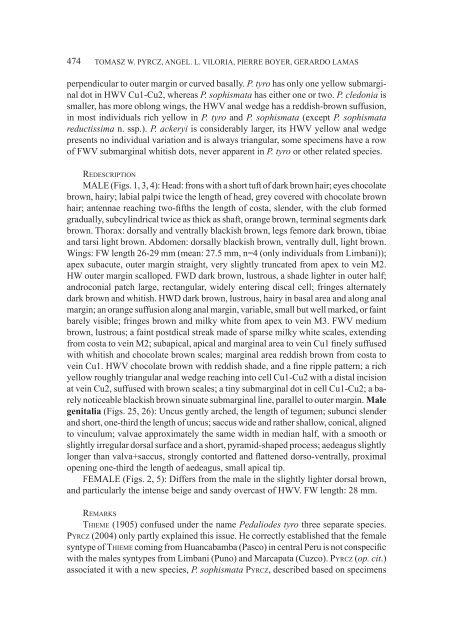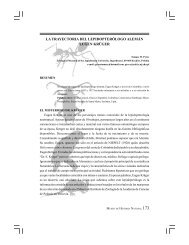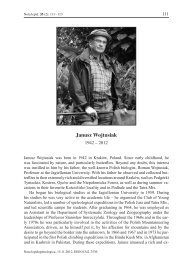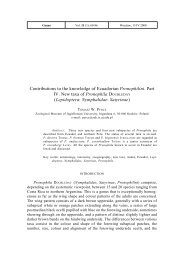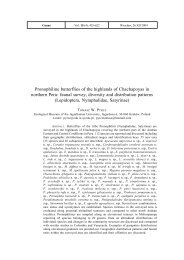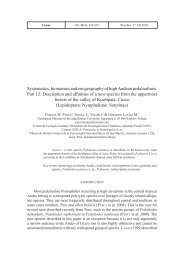Systematics, bionomics and zoogeography of high Andean ...
Systematics, bionomics and zoogeography of high Andean ...
Systematics, bionomics and zoogeography of high Andean ...
Create successful ePaper yourself
Turn your PDF publications into a flip-book with our unique Google optimized e-Paper software.
474 Tomasz W. Pyrcz, Angel. L. Viloria, Pierre Boyer, Gerardo Lamas<br />
perpendicular to outer margin or curved basally. P. tyro has only one yellow submarginal<br />
dot in HWV Cu1-Cu2, whereas P. sophismata has either one or two. P. cledonia is<br />
smaller, has more oblong wings, the HWV anal wedge has a reddish-brown suffusion,<br />
in most individuals rich yellow in P. tyro <strong>and</strong> P. sophismata (except P. sophismata<br />
reductissima n. ssp.). P. ackeryi is considerably larger, its HWV yellow anal wedge<br />
presents no individual variation <strong>and</strong> is always triangular, some specimens have a row<br />
<strong>of</strong> FWV submarginal whitish dots, never apparent in P. tyro or other related species.<br />
Redescription<br />
MALE (Figs. 1, 3, 4): Head: frons with a short tuft <strong>of</strong> dark brown hair; eyes chocolate<br />
brown, hairy; labial palpi twice the length <strong>of</strong> head, grey covered with chocolate brown<br />
hair; antennae reaching two-fifths the length <strong>of</strong> costa, slender, with the club formed<br />
gradually, subcylindrical twice as thick as shaft, orange brown, terminal segments dark<br />
brown. Thorax: dorsally <strong>and</strong> ventrally blackish brown, legs femore dark brown, tibiae<br />
<strong>and</strong> tarsi light brown. Abdomen: dorsally blackish brown, ventrally dull, light brown.<br />
Wings: FW length 26-29 mm (mean: 27.5 mm, n=4 (only individuals from Limbani));<br />
apex subacute, outer margin straight, very slightly truncated from apex to vein M2.<br />
HW outer margin scalloped. FWD dark brown, lustrous, a shade lighter in outer half;<br />
<strong>and</strong>roconial patch large, rectangular, widely entering discal cell; fringes alternately<br />
dark brown <strong>and</strong> whitish. HWD dark brown, lustrous, hairy in basal area <strong>and</strong> along anal<br />
margin; an orange suffusion along anal margin, variable, small but well marked, or faint<br />
barely visible; fringes brown <strong>and</strong> milky white from apex to vein M3. FWV medium<br />
brown, lustrous; a faint postdical streak made <strong>of</strong> sparse milky white scales, extending<br />
from costa to vein M2; subapical, apical <strong>and</strong> marginal area to vein Cu1 finely suffused<br />
with whitish <strong>and</strong> chocolate brown scales; marginal area reddish brown from costa to<br />
vein Cu1. HWV chocolate brown with reddish shade, <strong>and</strong> a fine ripple pattern; a rich<br />
yellow roughly triangular anal wedge reaching into cell Cu1-Cu2 with a distal incision<br />
at vein Cu2, suffused with brown scales; a tiny submarginal dot in cell Cu1-Cu2; a barely<br />
noticeable blackish brown sinuate submarginal line, parallel to outer margin. Male<br />
genitalia (Figs. 25, 26): Uncus gently arched, the length <strong>of</strong> tegumen; subunci slender<br />
<strong>and</strong> short, one-third the length <strong>of</strong> uncus; saccus wide <strong>and</strong> rather shallow, conical, aligned<br />
to vinculum; valvae approximately the same width in median half, with a smooth or<br />
slightly irregular dorsal surface <strong>and</strong> a short, pyramid-shaped process; aedeagus slightly<br />
longer than valva+saccus, strongly contorted <strong>and</strong> flattened dorso-ventrally, proximal<br />
opening one-third the length <strong>of</strong> aedeagus, small apical tip.<br />
FEMALE (Figs. 2, 5): Differs from the male in the slightly lighter dorsal brown,<br />
<strong>and</strong> particularly the intense beige <strong>and</strong> s<strong>and</strong>y overcast <strong>of</strong> HWV. FW length: 28 mm.<br />
Remarks<br />
Thieme (1905) confused under the name Pedaliodes tyro three separate species.<br />
Pyrcz (2004) only partly explained this issue. He correctly established that the female<br />
syntype <strong>of</strong> Thieme coming from Huancabamba (Pasco) in central Peru is not conspecific<br />
with the males syntypes from Limbani (Puno) <strong>and</strong> Marcapata (Cuzco). Pyrcz (op. cit.)<br />
associated it with a new species, P. sophismata Pyrcz, described based on specimens


